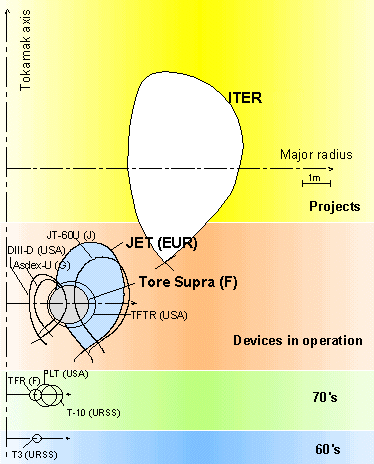|
The main tokamaks throughout the world 
The tokamak family is a big one! Take the time to get to know one or two of their members.
The beginnings of controlled thermonuclear fusion were at the end of the fifties, with declassification of research on the subject in 1957 in the USA (see History of magnetic fusion). Then came into being organisations of world international collaboration like the IAEA (International Atomic Energy Agency,
IAEA
 ) or European counterparts like Euratom. In the sixties, the tokamak concept was developed by Russian scientists, and during the
IAEA conference in 1968, the latter made a big impression by presenting the results on their T3 machine, which attained keV temperatures and confinement times of milliseconds. Following these results, a great number of small machines were built in many laboratories throughout the world. This was the era of TFR (the Tokamak in Fontenay aux Roses) in France. The eighties saw the arrival of the large machines, with 3 giants, TFTR in the United States, JT-60 in Japan and JET in Europe. It was also the time that Tore Supra was built, first large-scale tokamak equipped with supra-conducting magnets.
Also, existing machines were upgraded, Doublet became DIIID in the States, Asdex became Asdex-Upgrade in Germany, and JT-60 became JT- 60 Upgrade in Japan. Finally, the nineties were dedicated to designing the next generation machine, ITER, a large scale international project, initially uniting Europe, Japan, Russia and the USA, before reducing to 3 partners (Europe, Japan and Russia) in the final
engineering phase. ) or European counterparts like Euratom. In the sixties, the tokamak concept was developed by Russian scientists, and during the
IAEA conference in 1968, the latter made a big impression by presenting the results on their T3 machine, which attained keV temperatures and confinement times of milliseconds. Following these results, a great number of small machines were built in many laboratories throughout the world. This was the era of TFR (the Tokamak in Fontenay aux Roses) in France. The eighties saw the arrival of the large machines, with 3 giants, TFTR in the United States, JT-60 in Japan and JET in Europe. It was also the time that Tore Supra was built, first large-scale tokamak equipped with supra-conducting magnets.
Also, existing machines were upgraded, Doublet became DIIID in the States, Asdex became Asdex-Upgrade in Germany, and JT-60 became JT- 60 Upgrade in Japan. Finally, the nineties were dedicated to designing the next generation machine, ITER, a large scale international project, initially uniting Europe, Japan, Russia and the USA, before reducing to 3 partners (Europe, Japan and Russia) in the final
engineering phase.
The table below shows the features of a few tokamaks.
| |
Tore Supra (France) |
Asdex-U (Germany) |
Textor (Germany) |
JET (European Union in the UK) |
TFTR (USA) (machine closed) |
DIIID (USA) |
JT-60U (Japan) |
| Specificity |
¨
= |
r |
= |
r1< |
=
1 |
r |
r |
| Major radius R (m) |
2.36 |
1.65 |
1.75 |
2.96 |
2.48 |
1.67 |
3.45 |
| Minor radius a (m) |
0.8 |
0.5 |
0.5 |
1.25 |
0.85 |
0.67 |
1.2 |
| Minorradius b (m) |
0.8 |
0.8 |
0.5 |
2.10 |
0.85 |
1.36 |
1.68 |
| Toroidal field (Teslas) |
4.5 |
4 |
2 |
3.45 |
5.2 |
2.2 |
4.4 |
| Plasma current (MA) |
1.7 |
1.6 |
0.65 |
7 |
2.5 |
3.5 |
5 |
r
: machine fitted with an axisymetric
divertor
=
: machine fitted with a limiter
1
: machine suitable for tritium
¨
: permanent toroidal magnetic field produced supra-conducting magnets
<
: machine with remote handling of internal components
| Here are the same ones on a diagram showing the development in machine size, with in particular the largest current machine, JET, and the international project ITER.
Nevertheless, in addition to the machines quoted
above, there are many other experiments, each very specific (MAST and Compass D in Great
Britain, Castor in the Czech Republic, FTU in Italy, TCV in Switzerland, Alcator CMod in the USA, TdeV in Canada and so on. It is hard to be exhaustive!). The fusion research programme is organised on a European
scale, so as to coordinate efforts. Each national programme has its own specific features and tries to be complementary to that of its
partners. All countries participate in work on the next generation machine.
You will find links to the main fusion research laboratories here. |
 |
|
|